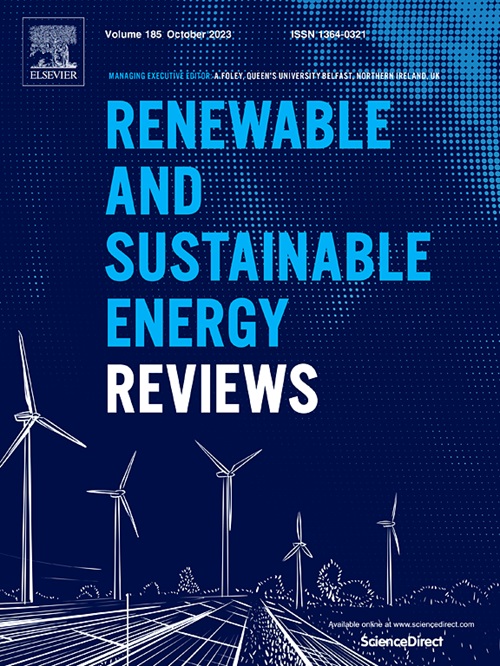Floating photovoltaic system based electrical power generation study in Indian context
IF 16.3
1区 工程技术
Q1 ENERGY & FUELS
引用次数: 0
Abstract
The world is transitioning towards a net zero emissions future and solar energy is leading the change. The land use requirements to install solar photovoltaic farms present a barrier for the industry as population density increases and land prices rise. The floating photovoltaic system is an emerging power generation system that is sparking prevalent interest due to its several benefits, including fewer obstacles to block sunlight, convenience, energy efficiency, and higher power generation efficiency due to the lower temperature underneath the panels. Floating solar is installing on the rise around the world, and many countries are starting to see it as a feasible preference. It has many benefits over ground-mounted photovoltaic which are discussed in this review. In this review, we look at the most current research on floating solar and discuss its advantages, disadvantages, and potential for the future. A comprehensive assessment of the floating solar system is carried out to analyze the performance enhancement through the installation methods of floating solar systems, along with the challenges. The study explores global floating solar development scenarios, highlighting research interest in sustainable solar energy solutions. It supports United Nation sustainability development goal 7 and 13, accelerating the transition to a low-carbon future. This study indicates that optimal tilt angle for floating solar panels is crucial for maximum power output. However, research on bifacial solar photovoltaic panels is underexplored. The taxonomy provides quantitative performance data such optimal tilt angle, performance parameters, study duration, data acquisition system specs, and major findings from current studies.
基于浮动光伏发电系统的印度发电研究
世界正在向净零排放的未来过渡,而太阳能正在引领这一变化。随着人口密度的增加和土地价格的上涨,安装太阳能光伏农场的土地使用要求对该行业构成了障碍。浮动光伏发电系统是一种新兴的发电系统,由于其几个优点引起了广泛的兴趣,包括阻挡阳光的障碍更少,方便,能源效率,以及由于面板下方温度较低而产生的更高的发电效率。漂浮式太阳能在世界各地的安装量正在上升,许多国家开始将其视为可行的首选方案。与地面安装的光伏相比,它具有许多优点,本文将对此进行讨论。在这篇综述中,我们回顾了目前关于浮动太阳能的最新研究,并讨论了它的优点、缺点和未来的潜力。对浮式太阳能系统进行了综合评估,分析了浮式太阳能系统安装方式对性能的提升以及面临的挑战。该研究探讨了全球浮动太阳能的发展前景,突出了可持续太阳能解决方案的研究兴趣。它支持联合国可持续发展目标7和13,加速向低碳未来过渡。该研究表明,浮动太阳能电池板的最佳倾斜角度对最大功率输出至关重要。然而,对双面太阳能光伏板的研究还不够深入。该分类法提供了定量的性能数据,如最佳倾斜角、性能参数、研究持续时间、数据采集系统规格和当前研究的主要发现。
本文章由计算机程序翻译,如有差异,请以英文原文为准。
求助全文
约1分钟内获得全文
求助全文
来源期刊

Renewable and Sustainable Energy Reviews
工程技术-能源与燃料
CiteScore
31.20
自引率
5.70%
发文量
1055
审稿时长
62 days
期刊介绍:
The mission of Renewable and Sustainable Energy Reviews is to disseminate the most compelling and pertinent critical insights in renewable and sustainable energy, fostering collaboration among the research community, private sector, and policy and decision makers. The journal aims to exchange challenges, solutions, innovative concepts, and technologies, contributing to sustainable development, the transition to a low-carbon future, and the attainment of emissions targets outlined by the United Nations Framework Convention on Climate Change.
Renewable and Sustainable Energy Reviews publishes a diverse range of content, including review papers, original research, case studies, and analyses of new technologies, all featuring a substantial review component such as critique, comparison, or analysis. Introducing a distinctive paper type, Expert Insights, the journal presents commissioned mini-reviews authored by field leaders, addressing topics of significant interest. Case studies undergo consideration only if they showcase the work's applicability to other regions or contribute valuable insights to the broader field of renewable and sustainable energy. Notably, a bibliographic or literature review lacking critical analysis is deemed unsuitable for publication.
 求助内容:
求助内容: 应助结果提醒方式:
应助结果提醒方式:


